-
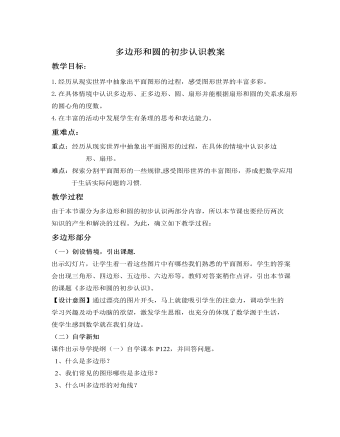
北师大初中七年级数学上册多边形和圆的初步认识教案2
1、 如图4-25,将一个圆分成三个大小相同的扇形,你能算出它们的圆心角的度数吗?你知道每个扇形的面积和整个圆的面积的关系吗?与同伴进行交流2、 画一个半径是2cm的圆,并在其中画一个圆心为60º的扇形,你会计算这个扇形的面积吗?与同伴交流。教师对答案进行汇总,讲解本题解题思路:1、 因为一个圆被分成了大小相同的扇形,所以每个扇形的圆心角相同,又因为圆周角是360º,所以每个扇形的圆心角是360º÷3=120º,每个扇形的面积为整个圆的面积的三分之一。2、 先求出这个圆的面积S=πR²=4π,60÷360=1/6扇形面积=4π×1/6=2π/3【设计意图】运用小组合作交流的方式,既培养了学生的合作意识和能力,又达到了互帮互助以弱带强的目的,使学习比较吃力的同学也能参与到学习中来,体现了学生是学习的主体。
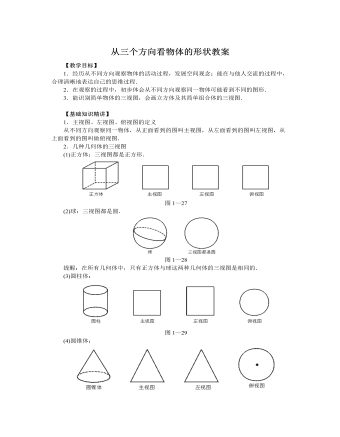
北师大初中七年级数学上册从三个方向看物体的形状教案2
【教学目标】1.经历从不同方向观察物体的活动过程,发展空间观念;能在与他人交流的过程中,合理清晰地表达自己的思维过程.2.在观察的过程中,初步体会从不同方向观察同一物体可能看到不同的图形.3.能识别简单物体的三视图,会画立方体及其简单组合体的三视图.【基础知识精讲】1.主视图、左视图、俯视图的定义从不同方向观察同一物体,从正面看到的图叫主视图,从左面看到的图叫左视图,从上面看到的图叫做俯视图.2.几种几何体的三视图(1)正方体:三视图都是正方形.圆锥的主视图、左视图都是三角形,而俯视图的图中有一个点表示圆锥的顶点,因为从上往下看圆锥时先看到圆锥的顶点,再看到底面的圆.3.如何画三视图 当用若干个小正方体搭成新的几何体,如何画这个新的几何体的三视图?
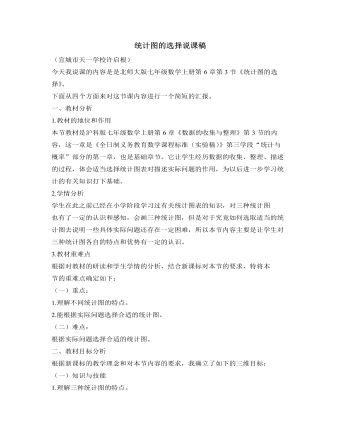
北师大初中数学七年级上册统计图的选择说课稿
四、教学过程分析为有序、有效地进行教学,本节课我主要安排了以下教学环节:(一)复习导入主要复习一下三种统计图,为接下来介绍三种统计图的特点及根据实际问题选取适当的统计图做好知识准备。(二)问题探究选取课本上“小华对1992~2002年同学家中有无电视机及近一年来同学在家看电视的情况”的3个调查项目,进而设计3个探究问题从而加深学生对每一种统计图的进一步认识,至此用自己的语言总结出每一种统计图的特点。(三)实践练兵这一环节通过2个实际问题的设计,通过学生对问题的分析、讨论,使学生认识到适当选取统计图有助于帮助人们去更快速、更准确地获取信息。(四)课堂小结总结这一节课所学的重点知识,这部分主要是让学生自己去总结,看看这节课自己有哪些收获。(五)作业布置进一步巩固本节课所学的知识,达到教学效果。以上就是我对这节课的见解,不足之处还望批评和指正。
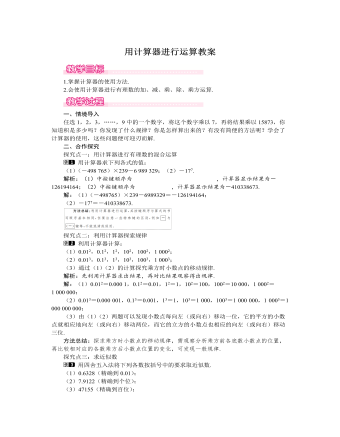
北师大初中七年级数学上册用计算器进行运算教案1
用四舍五入法将下列各数按括号中的要求取近似数.(1)0.6328(精确到0.01);(2)7.9122(精确到个位);(3)47155(精确到百位);(4)130.06(精确到0.1);(5)4602.15(精确到千位).解析:(1)把千分位上的数字2四舍五入即可;(2)把十分位上的数字9四舍五入即可;(3)先用科学记数法表示,然后把十位上的数字5四舍五入即可;(4)把百分位上的数字6四舍五入即可;(5)先用科学记数法表示,然后把百位上的数字6四舍五入即可.解:(1)0.6328≈0.63(精确到0.01);(2)7.9122≈8(精确到个位);(3)47155≈4.72×104(精确到百位);(4)130.06≈130.1(精确到0.1);(5)4602.15≈5×103(精确到千位).方法总结:按精确度找出要保留的最后一个数位,再按下一个数位上的数四舍五入即可.三、板书设计教学过程中,强调学生自主探索和合作交流,经历观察、操作、归纳、积累等思维过程,从中获得数学知识与技能,体验教学活动的方法,发展推理能力,同时升华学生的情感态度和价值观.
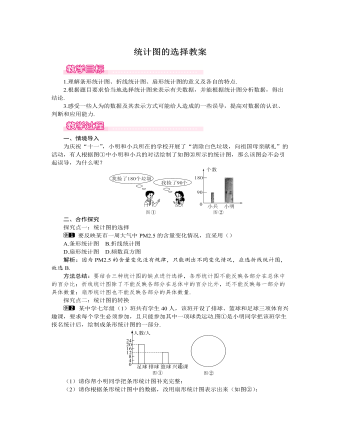
北师大初中七年级数学上册统计图的选择教案1
(1)该校被抽查的学生共有多少名?(2)现规定视力5.1及以上为合格,若被抽查年级共有600名学生,估计该年级在2015年有多少名学生视力合格.解析:由折线统计图可知2015年被抽取的学生人数,且扇形统计图中对应的A区所占的百分比已知,由此即可求出被抽查的学生人数;根据扇形统计图中C、D区所占的百分比,即可求出该年级在2015年有多少名学生视力合格.解:(1)该校被抽查的学生人数为80÷40%=200(人);(2)估计该年级在2015年视力合格的学生人数为600×(10%+20%)=180(人).方法总结:本题的解题技巧在于从两个统计图中获取正确的信息,并互相补充互相利用.例如求被抽查的学生人数时,由折线统计图可知2015年被抽取的学生人数是80人,与其相对应的是扇形统计图中的A区,而A区所占的百分比是40%,由此求出被抽查的学生人数为80÷40%=200(人).
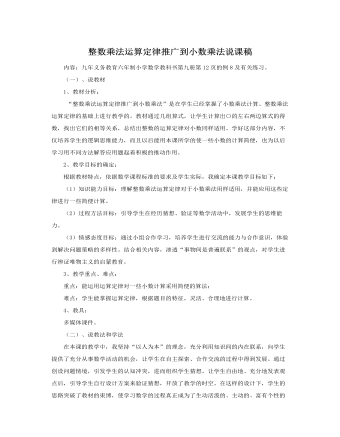
人教版新课标小学数学五年级上册整数乘法运算定律推广到小数乘法说课稿
“整数乘法运算定律推广到小数乘法”是在学生已经掌握了小数乘法计算、整数乘法运算定律的基础上进行教学的。教材通过几组算式,让学生计算出○的左右两边算式的得数,找出它们的相等关系,总结出整数的运算定律对小数同样适用。学好这部分内容,不仅培养学生的逻辑思维能力,而且以后能用本课所学的使一些小数的计算简便,也为以后学习用不同方法解答应用题起着积极的推动作用。2、教学目标的确定:根据教材特点,依据数学课程标准的要求及学生实际,我确定本课教学目标如下:(1)知识能力目标:理解整数乘法运算定律对于小数乘法用样适用,并能应用这些定律进行一些简便计算。(2)过程方法目标:引导学生在经历猜想、验证等数学活动中,发展学生的思维能力。(3)情感态度目标:通过小组合作学习,培养学生进行交流的能力与合作意识,体验到解决问题策略的多样性。结合相关内容,渗透“事物间是普遍联系”的观点,对学生进行辨证唯物主义的启蒙教育。

人教版新课标小学数学二年级上册两位数加两位数(进位加) 说课稿2篇
一、说教材:本课时主要的内容就是让学生在情境中掌握两位数加两位数的进位加法计算,让学生通过尝试和探索出多种算法,体验多种算法,然后比较出最好的算法。教学目标:1、通过具体的情境使学生更一步的理解加法的意义和提高学生的估算意识。2、通过学生的合作学习从而能探讨出多种计算两位数减两位退位减法的方法。3、培养学生的数学口语表达能力,提高学生的学习兴趣。4、掌握两位数加两位数(进位加)竖式的写法。重点:(1)通过学生的合作学习从而能探讨出多种计算两位数减两位退位减法的方法。(2)掌握笔算加法的计算法则。难点:对多样化算法进行优化,达到正确完成计算。发展学生的估算意识、和探究意识和解决实际问题的能力。二、说教法:组织学生在前面计算的基础上,自主探索出两位数加两位(进位加)的计算方法,并通过交流、讨论,达到对算法的优化,在通过“试一试”、“算一算”、“想一想”等形式达到知识的掌握。

人教版新课标小学数学二年级上册两位数减两位数(退位减)说课稿2篇
一、说教材1、教学内容本节课是义务教育课程标准实验教材人教版小学数学第三册18至19页的内容。它是在学生学习了20以内的退位减法、两位数减一位数和两位数减整十数以及两位数减两位数的不退位减法笔算的基础上学习的。它是以后学习多位数减法的重要基础。2、教学目标(1)、知识目标:使学生在理解算理的基础上初步掌握两位数退位减法的计算方法,并能正确的进行计算。(2)、技能目标:培养学生的动手操作能力,发展学生的思维和语言表达能力。(3)、情感目标:通过情景的创设,培养学生的爱国之情,同时让学生在自主探索算法的基础上体验到成功的喜悦。3、教学重点:本节课的重点是理解笔算两位数退位减的算理,能正确用竖式计算。4、教学难点:理解两位数减两位数退位减法的算理。
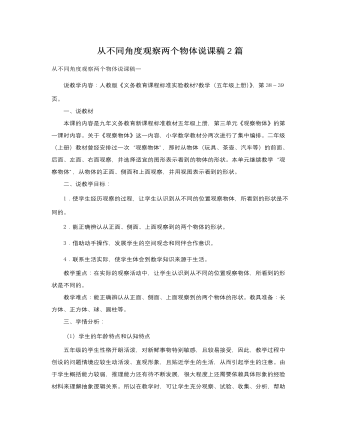
人教版新课标小学数学五年级上册从不同角度观察两个物体说课稿2篇
自主探究法:教学中强调以学生为主体,强调学生参与知识的形成过程,始终做到为学生提供充足的学习素材、创设充分学习的空间、时间,让学生自主探究,体验知识形成的过程,培养主动探究的能力。观察法:例1观察物体教学中的观察是很好的学习方法。例如,教学例1时,观察目的明确。教师通过让学生观察长方体物体学会从不同角度观察物体的方法。这一安排不仅给学生独立思考的机会,而且教给学生观察的思维方法。四、说教学程序在提出问题中,引发学生思考;在自主探索中,激发学生创新思维;在展示交流中,感受学生的个性;在总结陈述中,体验成功的乐趣;在联想记忆中进一步发挥学生的创造才能。在设计这节课时,我在尊重教材的基础上,力求体现新课标的新理念、新思想,导学案中设计了以下几个教学环节:
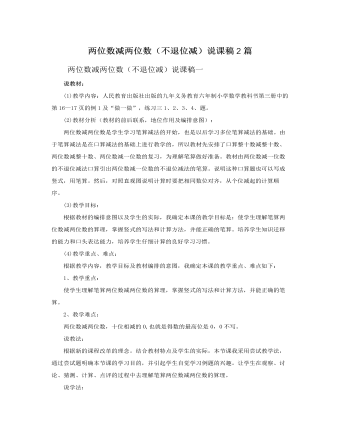
人教版新课标小学数学二年级上册两位数减两位数(不退位减)说课稿2篇
说教材:(1)教学内容:人民教育出版社出版的九年义务教育六年制小学数学教科书第三册中的第16—17页的例1及“做一做”,练习三1、2、3、4、题。(2)教材分析(教材的前后联系,地位作用及编排意图):两位数减两位数是学生学习笔算减法的开始,也是以后学习多位笔算减法的基础。由于笔算减法是在口算减法的基础上进行教学的,所以教材先安排了口算整十数减整十数、两位数减整十数、两位数减一位数的复习,为理解笔算做好准备。教材由两位数减一位数的不退位减法口算引出两位数减一位数的不退位减法的笔算。说明这种口算题也可以写成竖式,用笔算。然后,对照直观图说明计算时要把相同数位对齐,从个位减起的计算顺序。(3)教学目标:根据教材的编排意图以及学生的实际,我确定本课的教学目标是:使学生理解笔算两位数减两位数的算理,掌握竖式的写法和计算方法,并能正确的笔算。培养学生知识迁移的能力和口头表达能力,培养学生仔细计算的良好学习习惯。
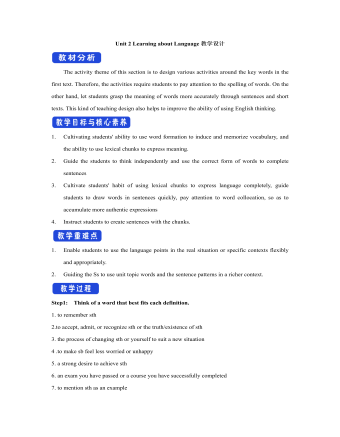
新人教版高中英语选修2Unit 2 Learning about Language教学设计
The activity theme of this section is to design various activities around the key words in the first text. Therefore, the activities require students to pay attention to the spelling of words. On the other hand, let students grasp the meaning of words more accurately through sentences and short texts. This kind of teaching design also helps to improve the ability of using English thinking.1. Cultivating students' ability to use word formation to induce and memorize vocabulary, and the ability to use lexical chunks to express meaning.2. Guide the students to think independently and use the correct form of words to complete sentences3. Cultivate students' habit of using lexical chunks to express language completely, guide students to draw words in sentences quickly, pay attention to word collocation, so as to accumulate more authentic expressions4. Instruct students to create sentences with the chunks.1. Enable students to use the language points in the real situation or specific contexts flexibly and appropriately.2. Guiding the Ss to use unit topic words and the sentence patterns in a richer context.Step1: Think of a word that best fits each definition.1. to remember sth2.to accept, admit, or recognize sth or the truth/existence of sth3. the process of changing sth or yourself to suit a new situation4 .to make sb feel less worried or unhappy5. a strong desire to achieve sth
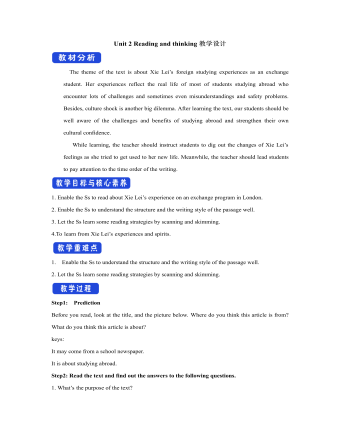
新人教版高中英语选修2Unit 2 Reading and thinking教学设计
Her tutor told her to acknowledge __________ other people had said if she cited their ideas, and advised her _______(read) lots of information in order to form __________wise opinion of her own.Now halfway __________ her exchange year, Xie Lei felt much more at home in the UK. She said __________ (engage) in British culture had helped and that she had been__________ (involve) in social activities. She also said while learning about business, she was acting as a cultural messenger __________(build) a bridge between the two countries. keys:Xie Lei, a 19yearold Chinese student, said goodbye to her family and friends in China and boarded (board) a plane for London six months ago in order to get a business qualification. She was ambitious(ambition) to set up a business after graduation. It was the first time that she had left (leave) home.At first, Xie Lei had to adapt to life in a different country. She chose to live with a host family, who can help with her adaptation (adapt) to the new culture. When she missed home, she felt comforted (comfort) to have a second family. Also Xie Lei had to satisfy academic requirements. Her tutor told her to acknowledge what other people had said if she cited their ideas, and advised her to read lots of information in order to form a wise opinion of her own.Now halfway through her exchange year, Xie Lei felt much more at home in the UK. She said engaging (engage) in British culture had helped and that she had been involved (involve) in social activities. She also said while learning about business, she was acting as a cultural messenger building a bridge between the two countries.
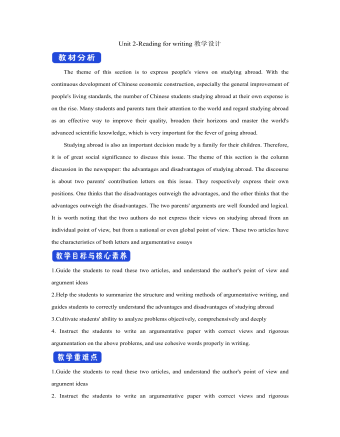
新人教版高中英语选修2Unit 2 Reading for writing教学设计
The theme of this section is to express people's views on studying abroad. With the continuous development of Chinese economic construction, especially the general improvement of people's living standards, the number of Chinese students studying abroad at their own expense is on the rise. Many students and parents turn their attention to the world and regard studying abroad as an effective way to improve their quality, broaden their horizons and master the world's advanced scientific knowledge, which is very important for the fever of going abroad. Studying abroad is also an important decision made by a family for their children. Therefore, it is of great social significance to discuss this issue. The theme of this section is the column discussion in the newspaper: the advantages and disadvantages of studying abroad. The discourse is about two parents' contribution letters on this issue. They respectively express their own positions. One thinks that the disadvantages outweigh the advantages, and the other thinks that the advantages outweigh the disadvantages. The two parents' arguments are well founded and logical. It is worth noting that the two authors do not express their views on studying abroad from an individual point of view, but from a national or even global point of view. These two articles have the characteristics of both letters and argumentative essays1.Guide the students to read these two articles, and understand the author's point of view and argument ideas2.Help the students to summarize the structure and writing methods of argumentative writing, and guides students to correctly understand the advantages and disadvantages of studying abroad3.Cultivate students' ability to analyze problems objectively, comprehensively and deeply
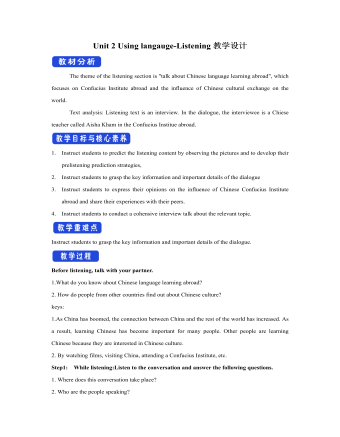
新人教版高中英语选修2Unit 2 Using langauge-Listening教学设计
? B: Absolutely! Getting involved with Chinese cultural activities there definitely helped a lot. I got to practice my Chinese on a daily basis, and I could learn how native Chinese speakers spoke.? A: What do you feel is your biggest achievement?? B: Learning Chinese characters! I have learnt about 1,500 so far. When I first started, I didn't think it was even going to be possible to learn so many, but now I find that I can read signs, menus, and even some easy newspaper articles.? A: What are you most keen on?? B: I've really become keen on learning more about the Chinese culture, in particular Chinese calligraphy. As I have learnt Chinese characters, I have developed a great appreciation for their meaning. I want to explore Chinese characters by learning how to write them in a more beautiful way. ? A: Finally, what do you want to say to anyone interested in learning Chinese?? I have really become keen on learning more about the Chinese culture, in particular Chinese Calligraphy. As I have learnt Chinese character, I have developed a great appreciation for their meaning. I want to explore Chinese characters by learning how to write them in a more beautiful way.? A: Finally, what do you want to say to anyone interested in learning Chinese?? B: I'd say, give it a shot! While some aspects may be difficult, it is quite rewarding and you will be happy that you tried.? A: Thanks for your time. ? B:You're welcome.

新人教版高中英语必修3Unit 2 Morals and virtues教学设计一
(2) students are divided into groups according to the requirements of activity 3. Each student shares a story of personal experience or hearing-witnessing kindness, and then selects the most touching story in the group and shares it with the whole class. Before the students share the story, the teacher can instruct them to use the words and sentence patterns in the box to express. For example, the words in the box can be classified:Time order: first of all, then, after that, later, finally logical relationship :so, however, although, butTeachers can also appropriately add some transitional language to enrich students' expression:Afterwards, afterwards, at last, in the end, eventuallySpatial order: next to, far from, on the left, in front ofOtherwise, nevertheless, as a result, therefore, furthermore, in addition, as well asSummary: in a word, in short, on the whole, to sum up, in briefStep 8 Homework1. Understand the definition of "moral dilemma" and establish a correct moral view;2. Accumulate vocabulary about attitudes and emotions in listening texts and use them to express your own views;3. Complete relevant exercises in the guide plan.1、通过本节内容学习,学生能否理解理解“道德困境”的定义;2、通过本节内容学习,学生能否通过说话人所表达的内容、说话的语气、语调等来判断其态度和情绪;3、通过本节内容学习,学生能否针对具体的道德困境发表自己的看法和见解,能否掌握听力理训练中的听力策略。
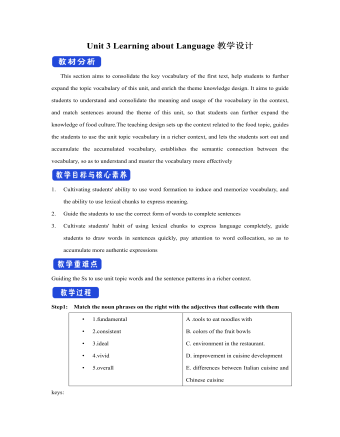
新人教版高中英语选修2Unit 3 Learning about Language教学设计
1. We'll need ten months at least to have the restaurant decorated.2.Some traditional Chinese dishes from before the Ming Dynasty are still popular today.3.My grandpa's breakfast mainly includes whole grain biscuits and a glass of milk.4.People in this area would eat nearly a kilo of cheese per week.5. We enjoyed a special dinner in a fancy restaurant where the waiters all wore attractive suits.6. He prefers this brand of coffee which, as he said, has an unusually good flavor.Key:1. at a minimum 2. prior to3. consist of4. consume5. elegant6. exceptionalStep 5:Familiarize yourself with some food idioms by matching the meaning on the right with the colored words on the left.1.Public concern for the health of farm animals has mushroomed in the UK2.Anderson may be young but he's certainly rolling to doing dough!3.George is a popular lecturer. He often peppers his speech with jokes.4.As the person to bring home the bacon, he needs to find a stable job.5 He is often regarded as a ham actor for his over emphasized facial expressions. The media reported that these companies had treated pollution as a hot potato. 6.The media reported that these companies had treated pollution as a hot potato.7.Don't worry about the test tomorrow. It's going to be a piece of cake!8. It's best to fold the swimming ring when it is as flat as a pancake.A. completely flatB. something that is very easy to do C.an issue that is hard to deal withD.to include large numbers of somethingE.to earn on e's living to support a familyF. wealthyG.to rapidly increase in numberH. an actor who performs badly, especially by over emphasizing emotions
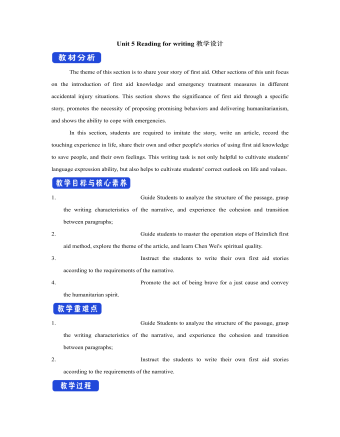
新人教版高中英语选修2Unit 5 Reading for writing教学设计
你校英语报计划出版一期急救常识专刊,现面向全校学生公开征集稿件,你有意参加。请你根据下面提示内容,用英语写一篇短文,介绍在车祸现场对伤者进行急救的方法和步骤。1.确保现场的安全;2.询问伤者,确保其呼吸正常;3.检查伤口,如流血则应采取止血措施;4.如需急救,确保其处于康复位置。注意:1.词数80左右;2.可以适当增加细节,以使行文连贯。参考词汇:康复位置 recovery positionAs we all know, having a knowledge of first aid can make a great difference in our daily life. If a traffic accident happens and someone is injured, the following steps can be used to treat the injured.In the first place, we should make sure that the accident scene is safe so that we won’t get hurt. We should ask the injured person if he is OK, and see if he is breathing. What’s more, we should check for cuts and wounds. If he is bleeding badly, it is vital that we should try to stop the bleeding by applying pressure to the injury. This is because if a person loses too much blood, he may die. If necessary, take the injured person to the hospital as soon as possible.Do remember: when giving first aid, please be sure to place the person in a recovery position.
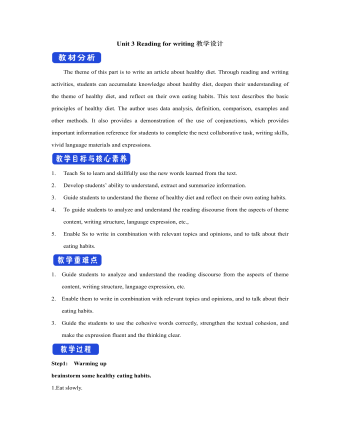
新人教版高中英语选修2Unit 3 Reading for writing教学设计
The theme of this part is to write an article about healthy diet. Through reading and writing activities, students can accumulate knowledge about healthy diet, deepen their understanding of the theme of healthy diet, and reflect on their own eating habits. This text describes the basic principles of healthy diet. The author uses data analysis, definition, comparison, examples and other methods. It also provides a demonstration of the use of conjunctions, which provides important information reference for students to complete the next collaborative task, writing skills, vivid language materials and expressions.1. Teach Ss to learn and skillfully use the new words learned from the text.2. Develop students’ ability to understand, extract and summarize information.3. Guide students to understand the theme of healthy diet and reflect on their own eating habits.4. To guide students to analyze and understand the reading discourse from the aspects of theme content, writing structure, language expression, etc., 5. Enable Ss to write in combination with relevant topics and opinions, and to talk about their eating habits.1. Guide students to analyze and understand the reading discourse from the aspects of theme content, writing structure, language expression, etc.2. Enable them to write in combination with relevant topics and opinions, and to talk about their eating habits.3. Guide the students to use the cohesive words correctly, strengthen the textual cohesion, and make the expression fluent and the thinking clear.Step1: Warming upbrainstorm some healthy eating habits.1.Eat slowly.2.Don’t eat too much fat or sugar.3.Eat healthy food.4.Have a balanced diet.Step2: Read the passage and then sum up the main idea of each paragraph.
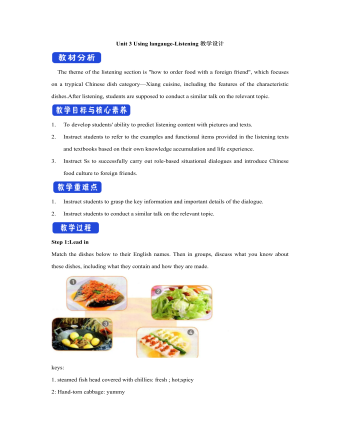
新人教版高中英语选修2Unit 3 Using langauge-Listening教学设计
1. How is Hunan cuisine somewhat different from Sichuan cuisine?The heat in Sichuan cuisine comes from chilies and Sichuan peppercorns. Human cuisine is often hotter and the heat comes from just chilies.2.What are the reasons why Hunan people like spicy food?Because they are a bold people. But many Chinese people think that hot food helps them overcome the effects of rainy or wet weather.3.Why do so many people love steamed fish head covered with chilies?People love it because the meat is quite tender and there are very few small bones.4.Why does Tingting recommend bridge tofu instead of dry pot duck with golden buns?Because bridge tofu has a lighter taste.5 .Why is red braised pork the most famous dish?Because Chairman Mao was from Hunan, and this was his favorite food.Step 5: Instruct students to make a short presentation to the class about your choice. Use the example and useful phrases below to help them.? In groups of three, discuss what types of restaurant you would like to take a foreign visitor to, and why. Then take turns role-playing taking your foreign guest to the restaurant you have chosen. One of you should act as the foreign guest, one as the Chinese host, and one as the waiter or waitress. You may start like this:? EXAMPLE? A: I really love spicy food, so what dish would you recommend?? B: I suggest Mapo tofu.? A: Really ? what's that?

新人教版高中英语选修2Unit 4 Using langauge-Listening教学设计
The theme of the listening section is " talking about scenery and culture along a journey."The part is designed to further lead the students to understand Canadian natural geography and social environment, and integrated into the cultural contrast by mentioning the long train journey from Beijing to Moscow routes. On this basis, the part activates students related travel experience, lets the student serial dialogue, guides the student to explore further the pleasure and meaning of the long journey, and Chinese and foreign cultural comparison.The part also provides a framework for the continuation of the dialogue, which is designed to provide a framework for students to successfully complete their oral expressions, and to incorporate an important trading strategy to end the dialogue naturally.1. Help students to understand and master some common English idioms in the context, and experience the expression effect of English idioms.2. Guide the students to understand the identity of different people in the listening context, and finish the dialogue according to their own experience.3. Instruct the students to use appropriate language to express surprise and curiosity about space and place in the dialogue, and master the oral strategy of ending the dialogue naturally.1. Instruct students to grasp the key information and important details of the dialogue.2. Instruct students to conduct a similar talk on the relevant topic.

